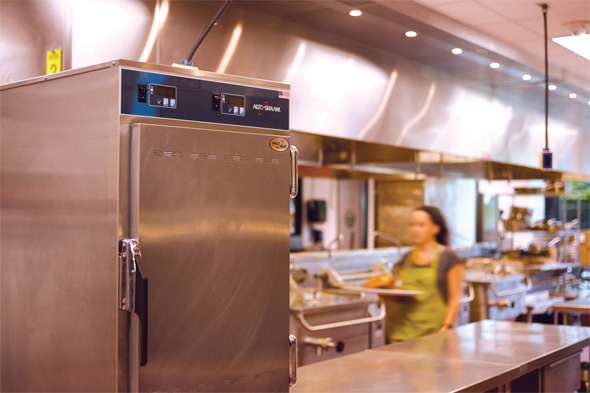Explore tips for safely reopening your restaurant or other on-premises dining program as our industry navigates COVID-19.
As states continue to lift Safer at Home orders and restrictions, the foodservice industry continues to work together to reimagine what safe on-premises dining looks like for customers and employees.
According to Technomic forecasting, a handful of trends and issues will likely compound both in the short term and beyond. The foodservice industry continues to be significantly impacted by the pandemic, with first quarter operator sales sharply declining 43% year over year. Additionally, Technomic predicts that in the best-case scenario, the industry will experience -17.7% decline in 2020 nominal sales growth.
With concerns over the state of the economy, the safety of employees and customers and business survival—foodservice operators continue to show resiliency as they expand off-premises programs and redesign their on-premises dining experience.
A number of resources and guidelines have been made available to support operators, including the U.S. FDA’s reopening checklist, and the CDC’s reopening decision tree. Additionally, below are a few tips to support restaurant operators as they restructure and reopen their business:
Rethinking Space
 Heated holding cabinets make time stand still in terms of product quality, with gentle, radiant heat.
Heated holding cabinets make time stand still in terms of product quality, with gentle, radiant heat.
As operators begin to reopen, one of the primary concerns is maintaining 6’ of social distance between customers and employees. Capacity in the dining room and kitchen will need to be reduced, as operators redesign and alter the layout of the kitchen and dining room. Many operators have built outdoor dining spaces, limited party sizes and required reservations to better manage social distancing and plan out traffic in the dining room.
In the kitchen, ventless, compact and multi-functional equipment could be the solution for enabling social distance between cooks. Exclusive Vector® H Series Multi-Cook Ovens feature up to four ovens in one, allowing operators to cook a variety of food items simultaneously while reducing labor and simplifying steps in food production. H Series ovens offer a compact, 21” footprint and are certified ventless, allowing operators to place the oven anywhere—to free up crowded kitchens, especially under kitchen hoods—while increasing food production. Featuring Structured Air Technology®, Vector ovens cook food at the highest quality, two times faster than conventional technology to keep up during peak service times.
Streamlining Workflows
 Heated holding cabinets make time stand still in terms of product quality, with gentle, radiant heat.
Heated holding cabinets make time stand still in terms of product quality, with gentle, radiant heat.
Equally important to the kitchen layout, kitchen workflow and reducing steps in food prep and production will be key. The right holding equipment allows operators to prepare menu items in advance, so that the kitchen is not crowded and employees are not working on-top of each other. Operators can keep product at its perfect serving temperature and hold for hours without overcooking or drying out. Alto-Shaam’s exclusive heated holding cabinets make time stand still in terms of product quality, with gentle, radiant Halo Heat® technology.
Maximizing Off-Premises Success
Moving forward, takeout and delivery will continue to be a key driver for restaurants—as customers re-acclimate to dine in and operators look to diversify their business and maintain revenue streams. As restaurants continue to focus on building to-go programs in the coming months, long-term sustainment will be essential. By choosing simple, easy-to-install equipment, operators can ensure that their existing equipment and systems are not pressured as they reopen their on-premises programs.
The easiest way to ensure that to-go orders do not disrupt future dine-in service is to dedicate a specific area for to-go orders. An existing kitchen design might not have room to duplicate equipment, which is why compact, ventless systems are crucial to support delivery and takeout programs. Ventless equipment provides added flexibility in terms of kitchen design. Operators are able to place this equipment anywhere outside of a traditional kitchen hood—maximizing floor space while improving efficiency and workflow. From cooking to holding to chilling, Alto-Shaam offers a complete system of foodservice equipment designed for delivery and takeout programs.
As you navigate reopening, Alto-Shaanm’s team of culinary experts are available to provide guidance tailored to your challenges and needs—from streamlining labor to kitchen layout to menu development and more.
For more information and ongoing support, contact Alto-Shaam’s culinary team



